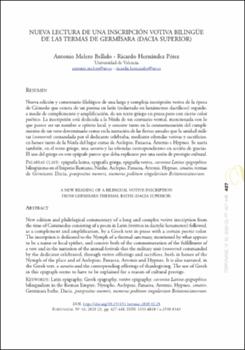Nueva lectura de una inscripción votiva bilingüe de las termas de Germísara (Dacia superior)
Date
2020Abstract
Nueva edición y comentario filológico de una larga y compleja inscripción votiva de la época
de Cómodo que consta de un poema en latín (redactado en hexámetros dactílicos) seguido,
a modo de complemento y amplificación, de un texto griego en prosa pero con cierto color
poético. La inscripción está dedicada a la Ninfa de un santuario termal, mencionada con lo
que parece ser un nombre o epíteto local, y consiste tanto en la conmemoración del cumplimiento
de un voto determinado como en la narración de las fiestas anuales que la unidad militar
(numerus) comandada por el dedicante celebraba, mediante ofrendas votivas y sacrificios,
en honor tanto de la Ninfa del lugar como de Asclepio, Panacea, Ártemis e Hypnos. Se narra
también, en el texto griego, una sanatio y las ofrendas correspondientes en acción de gracias.
El uso del griego en este epígrafe parece que deba explicarse por una razón de prestigio cultural. New edition and philological commentary of a long and complex votive inscription from
the time of Commodus consisting of a poem in Latin (written in dactylic hexameters) followed,
as a complement and amplification, by a Greek text in prose with a certain poetic color.
The inscription is dedicated to the Nymph of a thermal sanctuary, mentioned by what appears
to be a name or local epithet, and consists both of the commemoration of the fulfillment of
a vow and in the narration of the annual festivals that the military unit (numerus) commanded
by the dedicator celebrated, through votive offerings and sacrifices, both in honor of the
Nymph of the place and of Asclepius, Panacea, Artemis and Hypnos. It is also narrated, in
the Greek text, a sanatio and the corresponding offerings of thanksgiving. The use of Greek
in this epigraph seems to have to be explained for a reason of cultural prestige.





